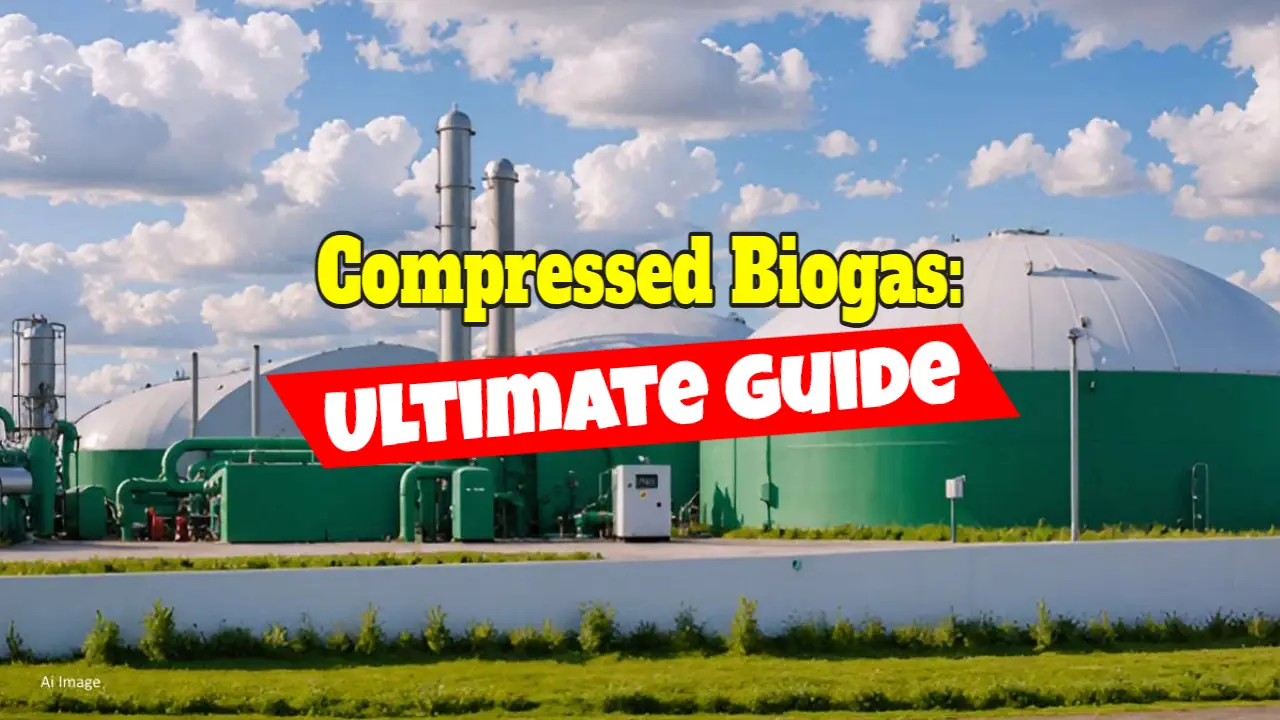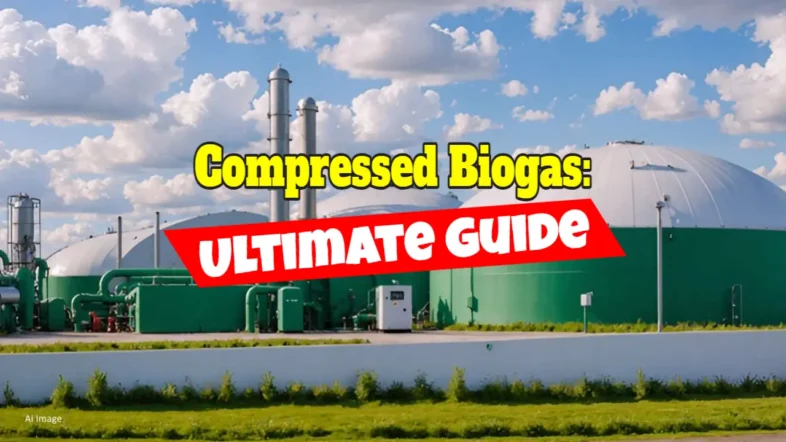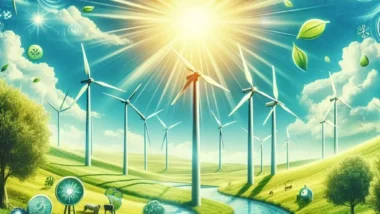Turning organic waste into something valuable is no small feat. Yet, with compressed biogas (CBG), it’s not just possible—it’s practical. Many natural gas users struggle with rising fossil fuel costs and their environmental impact. Others wonder how to tap into a more eco-friendly energy source without draining their wallets or running foul of regulations.
If so, look no further than compressed biogas (India and Asia terminology) or liquefied biomethane (Rest of the World terminology). India is taking the lead in compressed biogas:
Here’s an exciting fact:
India plans to establish 5,000 compressed biogas plants in phases, aiming to cut carbon emissions while tackling its dependence on LPG imports. This move isn’t just good for the planet; it also opens up new revenue streams for businesses.
In this guide, we'll cover everything—from selling CBG to complying with policies and crunching numbers on costs. By its end, you'll know how CBG could fit perfectly into your plans—or even transform them entirely! Ready? Let’s get started.
Key Takeaways
- India aims to build 5,000 compressed biogas (CBG) plants by 2025 under the SATAT scheme, producing 15 million tonnes annually. Outside India this is known as biomethane except the quality control standards differ slightly we are talking virtually pure methane.
- CBG is made from organic waste and reduces emissions compared to fossil-based compressed natural gas (CNG) in the west also called “Bio-LNG”. It also provides digestate for fertiliser use.
- Setting up a small or medium CBG plant costs ₹300–500 lakhs initially, with monthly operational expenses ranging from ₹20–45 lakhs. IREDA loans cover up to 70% of costs.
- Selling strategies include targeting industries, highlighting eco-benefits, and tapping into government blending obligations like in LPG replacements across India.
- Maintenance involves periodic checks costing £5,000–£10,000/year and specialised storage setup costing £20,000–£50,000 upfront to ensure safety compliance.

Definition
Compressed Biogas (CBG) is a clean, renewable gas made by processing organic materials like food waste or pig manure. Through anaerobic digestion, microorganisms break down this waste in a biogas reactor to produce methane (CH4).
The gas is purified and compressed to create CBG, which can replace fossil fuels.
CBG works as an alternative energy source for vehicles and industry. Unlike traditional natural gas, it reduces greenhouse gas emissions while supporting climate change mitigation goals.
India’s SATAT scheme promotes CBG plants for energy security and lower CO2 emissions. This process also produces digestate, useful as organic fertiliser for crops.
Compressed Biogas (CBG) Compared with Natural Gas (NG)
Compressed biogas (CBG) and compressed natural gas (CNG) may seem alike – after all they are both virtually pure methane – but their origins and characteristics set them apart. Below is a clear comparison to unravel their differences.
| Aspect | Compressed Biogas (CBG) | Compressed Natural Gas (CNG) |
|---|---|---|
| Source | Derived from organic waste, like agricultural residues or food waste. Example: Corn cobs in Lombok's plant. | Fossil-based natural gas extracted from underground reservoirs. |
| Carbon Footprint | Low, as it uses renewable sources. It also reduces methane emissions from decomposing organic matter. | Higher, since it relies on non-renewable fossil fuel extraction and combustion. |
| Production Volume | Dependent on local feedstock availability. Lombok's plant, for instance, makes 10 tonnes daily from corn cobs. | Produced on a much larger industrial scale due to vast underground reserves. |
| Energy Content | Variable, as it depends on feedstock quality. Often slightly lower than CNG. | Stable and consistent due to its uniform composition. |
| Cost | Potentially higher upfront, thanks to biogas processing plants. But, subsidies may reduce the burden. | Can be cheaper, as infrastructure is so widely available and established. But, this is changing! |
| Sustainability | Highly sustainable. Converts waste into energy, reducing landfill usage. | Far less sustainable, being tied to finite mineral resources. |
| Applications | Used for vehicle fuel, cooking, and power generation. Fits localised energy needs well. | Primarily a vehicle fuel (fuel delivered in cylinders) and industrial energy source. |
Natural gas users often find CBG appealing for its greener benefits, though its scale still lags behind CNG. It’s a vivid example of how waste can power our lives.
Selling Compressed Biogas

Selling compressed biogas needs a clear plan. Spotting interested buyers and winning them over is key, so make every offer count!
Target Markets and Primary Buyers
Compressed biogas has a growing demand among industries and vehicle fleets. Public transport systems can save money by switching from LPG or diesel. With India’s mandatory blending of compressed biogas policies, more factories are exploring cleaner energy options too.
Farmers often use it for fertiliser production due to its waste-to-use model. In Indonesia, where 6.7 million tonnes of LPG is imported annually, companies seek alternatives like compressed biogas to cut dependency on imports.
“Clean energy isn’t just the future; it's now.
Effective Sales Strategies for Compressed Biogas
Selling compressed biogas (CBG) needs focus and smart planning. Buyers value quality, pricing, and reliability.
- Offer competitive pricing. Industrial LPG users often look for cost-effective alternatives. Highlight how CBG competes well in price while being renewable.
- Build trust with industries and businesses needing clean energy. Target production plants, water treatment plants, and transportation companies using biofuels.
- Showcase eco-friendly benefits to attract environmentally conscious clients. Stress reduced landfill waste and lower carbon dioxide emissions from organic decay processes.
- Use case studies or success stories like Asia’s largest compressed biogas plant or Reliance’s projects to show proven results of CBG adoption.
- Attend global energy conferences to network. Events like the Global Conference on Compressed Biogas can connect you directly with big buyers or investors.
- Partner with government initiatives promoting renewable natural gas use or blending obligations in India like the Compressed Biogas Blending Obligation policy.
- Create local collaborations such as seen between Kaltimex Group and PT Gerbang NTB Emas in 2020 for joint projects that expand market reach.
- Make distribution convenient by investing in pipelines near industrial hubs or locations where wastes are processed into biofuel products.
- Highlight methane production efficiency through anaerobic decomposition when pitching to bulk buyers, showing how it meets large-scale demand sustainably.
- Emphasise long-term savings by comparing operational costs against traditional fuels during sales conversations using financial projections.
Regulatory Framework for Compressed Biogas
Rules shape how biogas can be made, stored, and sold. Knowing these rules helps avoid trouble and keeps projects running smoothly. Dive deeper to understand key policies impacting this market.

Compliance Obligations
Meeting compliance obligations is vital for compressed biogas companies in India. It ensures safety, quality, and adherence to government rules.
- Every compressed biogas plant must follow guidelines on methane purity levels to match fuel standards.
- Plants must install filters like membranes or activated carbon to remove hydrogen sulphide and impurities.
- Operators need permits from local environmental boards to control water contamination.
- Following the National Policy on Biofuels is mandatory for subsidies and incentives.
- Regular audits ensure a biogas plant’s emissions stay within allowed CO2 limits.
- Proper waste management practices are required to handle rotting biomass hygienically.
- Safety measures, including explosion-proof equipment like screw compressors, are compulsory under industrial laws.
- For blending compressed biogas with natural gas, plants must conform to blending obligations set by the government.
- Reporting production data helps authorities track renewable energy progress, linking it to goals like reducing LPG imports.
- Compliance with fire safety protocols protects against hazards from high-pressure storage systems used in operations.

Relevant Government Policies and Standards
India supports compressed biogas with several key policies. The Sustainable Alternative Towards Affordable Transportation (SATAT) scheme encourages the use of compressed biogas as a clean fuel, reducing dependence on crude oil imports.
This initiative promotes private investment in compressed biogas plants across India. Targets include establishing 5,000 plants by 2025, producing 15 million tonnes annually.
Clean energy today is not just a goal but our responsibility, said an Indian energy policy leader.
Blending requirements under India's renewable energy efforts require fuel providers to include biofuels like compressed biogas into their supply chain. Standards for purification processes and emissions control are stringent, ensuring safety and environmental benefits.
By adhering to these guidelines, producers cater to both domestic demand and export opportunities worldwide.
…
Next: Examine funding options that support growth in this green sector.
Funding for Compressed Biogas Projects
Grants, loans, and private investors can help turn your biogas idea into reality. Explore the options to find what fits your project's needs best!

Government Support and Subsidies
Government support greatly helps compressed biogas projects. Subsidies and policies make it easier to start and run operations.
- The Indian government launched the SATAT scheme in 2018. It plans to set up 5,000 compressed biogas plants by 2025. These plants aim to produce 15 million tonnes of CBG annually.
- Loans for these plants are given special treatment. The Reserve Bank of India lists loans up to INR 50 crore for CBG projects as priority sector lending.
- Financial incentives often reduce project costs. Many state governments provide further support like tax exemptions or lower electricity rates for CBG plants.
- Some subsidies cover machinery and equipment expenses. This directly lowers the initial cost of starting a compressed biogas plant.
- Investors can benefit from fast approvals through supportive policies for renewable energy businesses like this one.
- Policies also promote blending obligations with natural gas, boosting the demand for compressed biogas in industries across India.
Government initiatives encourage green fuel production, making activities like waste management more eco-friendly and profitable in the process!
Investment Opportunities from the Private Sector
Private sector investments are driving growth in compressed biogas projects. Companies and investors see potential in renewable energy.
- Many private entities support compressed biogas plants, especially in India. Reliance's focus on renewable energy helps push this sector forward.
- Venture capital firms often back such projects due to profits from growing demand for clean energy.
- Investors favour compressed biogas as it tackles waste dumped in landfills, turning it into fuel.
- Partnerships with industries needing bio-fuel or compost piles open funding opportunities for project developers.
- Financing through hypothecation or mortgage offers more options, making setup costs manageable.
- Green energy tax benefits attract investment from businesses aiming to reduce carbon dioxide emissions (CO2).
- The Indian Renewable Energy Development Agency (IREDA) seeks private partners for funding assistance till 2026.
- Increased global interest in reducing indoor pollution has strengthened confidence in biogas production ventures.
Investing here helps meet environmental goals and boosts financial returns simultaneously.
Cost Analysis for Compressed Biogas Operations
Setting up a compressed biogas plant needs careful planning, covering expenses like equipment, storage, and maintenance. The numbers might surprise you but could also excite you—dig deeper to learn more!
Initial Setup and Operational Costs
Getting started with a compressed biogas (CBG) project involves upfront investments and recurring expenses. Let’s break down the numbers and key components so you’ll have a clear picture of what lies ahead.
| Expense | Description | Estimated Costs (₹ Lakhs) |
|---|---|---|
| Land Acquisition | Land for setting up the biogas plant, typically 1-3 acres depending on output capacity. | 20-50 |
| Plant Machinery | Includes biogas digesters, compressors, desulphurisation units, and upgrading systems. | 150-300 |
| Construction Costs | Building the facility, infrastructure for feedstock handling, and storage units. | 100-150 |
| Feedstock Procurement | Securing agricultural residue, animal waste, or municipal solid waste. | 10-20 per month |
| Utilities | Electricity, water supply, and other operational utilities. | 5-15 per month |
| Operational Labour | Salaries of plant operators, technicians, and administrative staff. | 5-10 per month |
| Maintenance | Repairs and upkeep of the biogas plant, compressors, and other equipment. | 5-10 per month |
| Storage and Distribution | Cylinders, tanks, and transportation logistics for CBG. | 15-25 |
Government schemes like the IREDA loan are a major help. This covers 70% of the project cost, making it easier on your pocket. Loans typically follow a 70:30 debt-to-equity ratio, meaning you’ll need 30% of the total investment as equity.
Monthly operational expenses like feedstock, utilities, and labour range between ₹20-45 lakhs. Initial setups may cost around ₹300-500 lakhs for small to medium facilities.
Costs can vary based on technology and location. Regulations and funding opportunities are another side of the story worth exploring.
Maintenance and Storage Financials
Compressed Biogas (CBG) systems require consistent maintenance and efficient storage. Both are critical to operational success and cost efficiency. Below is a breakdown of financials related to maintaining and storing compressed biogas, presented in a simple table for clarity.
| Aspect | Key Details | Estimated Costs (GBP) |
|---|---|---|
| Periodic Maintenance | – Cleaning and inspecting compressors, pipelines, and valves – Regular checks to prevent leaks – Replacement of worn-out seals and moving parts | £5,000–£10,000/year |
| Emergency Repairs | – Unplanned issues like compressor failure or gas leakage – Requires prompt repairs and sometimes external specialists | £2,000–£6,000/incident |
| Pressure Cylinder Storage | – Cylinders store CBG at 200–250 Bar – Requires durable, tested tanks for safety – Periodic retesting of cylinders (every 5 years) | £300–£1,000/unit Retesting: £50–£100/unit |
| Storage Facility Setup | – Construction of specialised storage spaces with ventilation – Compliance with safety regulations – Fire detection and suppression systems | £20,000–£50,000 (one-time cost) |
| Routine Safety Inspections | – Bi-annual checks to meet government standards – Includes testing of detection systems and cylinder handling | £1,500–£3,000/year |
| Labour Costs | – Skilled workforce for maintenance and cylinder handling – Routine training for safety compliance | £15/hour/staff Total: £10,000–£15,000/year |
High-pressure cylinders come with added responsibility. Follow safety guidelines to avoid accidents. Maintenance costs, though non-negotiable, prevent larger losses. Storage costs may vary depending on location and scale.
With maintenance and storage costs covered, let’s explore the conclusion.

Conclusion
Selling compressed biogas is packed with opportunities. Understanding regulations, costs, and funding sources can set businesses on the right track. Governments are pushing for cleaner fuels, making this field promising.
With proper planning and strategy, success is within reach. It’s time to turn waste into energy and profit!
FAQs
1. What is the difference between biogas and compressed biogas?
Biogas is produced from biodegradable materials through an anaerobic digester. Compressed biogas, on the other hand, undergoes compression to remove impurities like hydrogen sulphide and carbon dioxide (CO2), making it suitable as a renewable energy source or bio-fuel.
2. How much does a compressed biogas plant cost in India?
The cost of setting up a compressed biogas plant in India varies depending on size and location. Factors like equipment such as pistons, positive displacement compressors, and sewage treatment systems also affect expenses.
3. Are there funding options available for compressed biogas plants?
Yes, several schemes support this sector, especially in India where initiatives encourage renewable energy projects. Project reports often include details about DSCR (Debt Service Coverage Ratio) for financing viability.
4. What are the regulations around selling compressed biogas?
Selling involves meeting blending obligations under policies like UPSC’s guidelines for bio-fuels in India. Auditors may review compliance with standards related to organic compounds or emissions during production.
5. Can Asia's largest compressed biogas plant impact costs globally?
Asia's largest facility could influence pricing trends by improving efficiency while reducing reliance on traditional fuels like firewood or charcoal across regions using similar technology.
6. Is it possible to generate electricity using compressed biogas plants?
Absolutely! These plants can convert gases into power via chemical reactions involving nitrogen or ammonia—a sustainable alternative that reduces dependency on fossil fuels while contributing to cleaner energy solutions worldwide!




